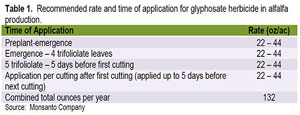When planting alfalfa always select a variety that will fit your area. New varieties with greater yield potential, better persistence, winter hardiness, disease resistance and improved forage quality have been developed in the last years.
Varieties will perform differently in various growing regions; look for varieties grown in similar soil type and climate to your farm as possible to determine yield potential.
Persistence depends on management. Expected persistence in Mississippi might be three to four years with good management practices. Fall dormancy determines how tall alfalfa will grow in the month following the last cutting.
Three areas of adaptation have to be considered in Mississippi. Dormant alfalfas (dormancy 4 to 5) will fit in the northern part of the state. Dormant and semi-dormant alfalfas (dormancy 5 to 7) will fit in the central part.
Semi-dormant and non-dormant alfalfas (dormancy 7 to 10) will fit the southern part of Mississippi. Semi-dormant and non-dormant varieties typically might recover faster after cuttings, yield more in the fall and might green up earlier in the spring.
Alfalfa requires a well-drained soil for optimum and production and establishment. Always soil test before planting. Liming is the most important part in establishing, maintaining high-yielding and high-quality alfalfa stands.
Alfalfa is sensitive to soil acidity and soil pH of 6.2 or above is required for optimum yield production. Apply lime at least six months (preferably 12 months) prior to seedling since lime reacts very slowly with soil acids.
Alfalfa is a legume that should fix most of its own N requirement. Applying 20 to 30 pounds of fertilizer N per acre at establishment will aid seedling growth while root nodules are forming. Phosphorous, potassium, boron and sulfur are important nutrients for a good establishment.
Poultry litter is a good source of macronutrients and micronutrients that could be used to satisfy alfalfa nutrient requirements. Testing the manure prior to application is recommended for application rates that will satisfy alfalfa nutrient needs. Avoid direct manure/seed contact.
Manure application prior to seeding should be incorporated into the soil. On soils with a relatively high leaching potential (sandy and sandy loam) apply manure within three to four weeks of seeding. On less leachable soils, manure may be applied in the fall before alfalfa seeding.
Fall seeding is preferred since adequate soil moisture and cool temperatures enhance germination and establishment. Alfalfa should be plated from mid-September to mid-October in a well-prepared seed bed at a seeding rate of 15 to 20 lbs per acre. No-till is better recommended for Round-up Ready varieties.
Plant seeds one quarter inch to one half inch deep in medium to heavy soils and one half inch to one inch deep on sandy soils. Alfalfa usually needs about six weeks growth after germination to store the necessary carbohydrates and survive the winter.
To ensure a proper nitrogen fixation, it is better to purchase pre-inoculated seed or treat the seeds using commercial inoculums. Nodules are the result of an infection by an effective strain of bacteria (Rhizobium meliloti).
The inoculum should be from the current year and should have been stored in a cool place in the store away from sunlight. Contact your local County Extension Office for the proper inoculating procedure.
One of the major challenges for alfalfa producers is a successful weed control using conventional herbicides. The most critical time for weed management in alfalfa is during establishment.
Weed infestation and competition during establishment will reduce seedling vigor and affect persistence and longevity of the perennial crop. Yield reduction in thinning stands results in loss of one half to one lb of yield for each pound of weeds produced. Alfalfa with the Roundup Ready trait is resistant to glyphosate herbicide which can be used to provide weed control.
Roundup Ready (RR) technology has been successfully incorporated into alfalfa. Keep in mind that RR varieties are not labeled for use in wildlife food plots because it is not intensively managed, which will increase the chances of seed production and dispersion.
In forage production, plots should be harvested at 1/10 bloom to minimize seed production. Producers that are planting RR alfalfa should provide their seed supplier/dealers with the Global Positioning System (GPS) coordinates of one point in each of all their RR alfalfa fields.
Roundup Ready alfalfa can provide high-quality, weed-free forage with excellent crop safety and minimal harvest restrictions. Roundup Ready alfalfa may also help in the establishment of no-till alfalfa stands, but it may not be appropriate for all situations.
An initial application of glyphosate between emergence and the fourth trifoliolate growth stage is important in establishing a thick and productive stand. Producer needs to be aware that 90 percent or more of the seed contains the RR trait.
That means that at least 10 percent of the plants might not contain the glyphosate resistance trait and at least 10 percent of the emerged plants might end up dying after a glyphosate application. Usually two glyphosate applications could provide excellent weed control.
 Other applications could also be possible throughout the growing season (Table 1). Some other herbicides approved for use in alfalfa like Pursuit (imazethapyr), Select 2EC (clethodim) or Buctril (bromoxynil) may be tank-mixed with glyphosate. Other herbicides might available for weed control as well. Contact your local County Extension Office for other weed control alternatives.
Other applications could also be possible throughout the growing season (Table 1). Some other herbicides approved for use in alfalfa like Pursuit (imazethapyr), Select 2EC (clethodim) or Buctril (bromoxynil) may be tank-mixed with glyphosate. Other herbicides might available for weed control as well. Contact your local County Extension Office for other weed control alternatives.
Many factors come into play when establishing alfalfa. The level of management might be more intensive than the traditional forage crops commonly grown in Mississippi.
Although production and quality factors might see appealing, it might not fit every forage production enterprise in the state. Keep in mind that alfalfa stands and yield will decline over the years due to environmental stress, traffic, disease and poor fertility. FG

Rocky Lemus
Extension Forage Specialist
Mississippi State University
—From Mississippi State University Extension Service e-newsletter Forage News, Vol. 4 Issue 10, October 2011










